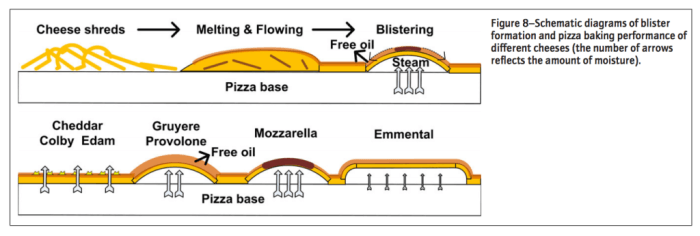
When it comes to crafting the perfect pizza, cheese is pretty darn important. For a truly amazing pie, one must find the ideal balance of melty, stretchy, browned, bubbling cheese living in harmony with everything else you choose to top it with. Thankfully, science has made pizza nirvana just a little simpler with a new study that has determined the ideal cheese for your next pizza night.
Aptly titled “Quantification of Pizza Baking Properties of Different Cheeses, and Their Correlation with Cheese Functionality,” the study looks at several cheesy characteristics that make for a great pizza. Scientists evaluated mozzarella, cheddar, Colby, Edam, Emmental, Gruyère, and provolone, and judged them on several properties, including “rheology [i.e., how a substance flows], free oil, transition temperature [between “elastic” and “viscous” states], and water activity.”
For a truly great pizza, cheese should blister and brown slightly as it melts, though for this to happen uniformly, a cheese must strike the right balance of moisture content and free oils. A Quartz article breaks it down in simple terms, and includes a handy visual, too.
[Cheese] needs to lose moisture first. For the moisture to evaporate, blisters need to form, because where they lift the surface of the cheese, free oil can run off and expose the surface to raw heat. And for a blister to form, steam needs to collect in a pocket and push up the cheese.

via Quartz
So which cheese reigned supreme? Mozzarella came out as top dog—its high moisture content creates steam as it’s heated, which in turn creates blisters, thanks to mozz’s elasticity. These blisters raise the cheese out of any free oils, which exposes the surface to direct heat and allows for a beautifully browned pizza top every time. Other less elastic cheeses struggle to form blisters, leaving you with an unbrowned (read: mediocre) pizza.
Now that you know the science behind mozzarella on pizza, how do you choose the right one? Serious Eats posed some interesting thoughts on local vs. imported versions of the popular Italian cheese. Author Liz Thorpe points out that while imported Italian mozzarella used to be perceived as superior to any American versions, freshness also plays a part in the lifespan of this highly perishable cheese. “A pristine ball of Italian mozzarella di bufala may turn sour and chewy by the time it reaches an American plate. Local mozzarella doesn’t have these problems to the same degree.” Click through to the article and see some of her picks for prime American mozz, coast-to-coast, or check out our Cheese Library to find some excellent picks in your area.
Photo by Food52




